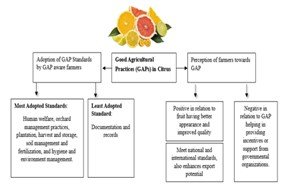Citrus growers' knowledge, attitudes, and implementation towards Good Agricultural Practices (GAPs) in Palpa, Nepal
Abstract
There is a high demand of citrus fruits in mid-hills region of Nepal. To increase its productivity, it is important to incorporate sustainable practices into orchard management. Therefore, the study was conducted in summer 2022 to understand commercial citrus farmers' knowledge on Good Agricultural Practices (GAPs) and correspond production methods of GAP aware farmers with GAP standards in the Palpa, Nepal. Altogether, 64 commercial citrus growers were interviewed with pre-tested semi-structured questionnaires for the data collection. The farmers were categorized into GAP aware and unaware based on the criteria made by the group discussion with the leading farmers and GAP standards. The result revealed that out of ten selected standards, adoption of GAP standards by GAP aware farmers are positive in relation to orchard management practices (99%), plantation (90%), harvest and storage (90%), soil management and fertilization (63%), and hygiene and environment management (61%)— with human welfare (100%) adopted by all of the aware respondents and GAP related to documentation and records (25%) were found to be least adopted. The entire aware respondents agreed to the fact that GAP produced fruit have a better appearance and improved quality, satisfies national and international standards and enhances the export potential of fruits but 97% of respondents didn’t agree that adopting GAP helps in providing incentives or support from governmental organizations. The understanding of GAP among the citrus growers is limited and hence, it is crucial to organize awareness programs and provide supplementary training sessions to enhance their understanding and adoption of GAP practices.
Keywords:
Adoption, Awareness, Certification, Documentation, GAPDownloads
References
Aydın, B., & Aktürk, D. (2018). Energy use efficiency and economic analysis of peach and cherry production regarding good agricultural practices in Turkey: A case study in Çanakkale province. Energy, 158, 967–974. https://doi.org/10.1016/J.ENERGY.2018.06.087
Bairagi, S., Mishra, A. K., & Giri, A. (2019). Good agricultural practices, farm performance, and input usage by smallholders: Empirical evidence from Nepal. Agribusiness, 35(3), 471–491. https://doi.org/10.1002/AGR.21577
Bernier, Q., Meinzen-Dick, R. S., Kristjanson, P. M., Haglund, E., Kovarik, C., Bryan, E., ... & Silvestri, S. (2015). Gender and institutional aspects of climate-smart agricultural practices: evidence from Kenya. CCAFS Working Paper.
Cochran, W.G. 1977. Sampling Techniques. 3rd ed. New York: John Wiley & Sons.
Danquah, E., Ennin, S., & Frimpong, F. R. J. (2015). Adoption of good agricultural practices for sustainable maize and cowpea production: The role of enabling policy. World Research Journal of Agricultural Sciences. 2(2), 028-038
Dorji, K., Lakey, L., Chophel, S., Dorji, S. D., & Tamang, B. (2016). Adoption of improved citrus orchard management practices: A micro study from Drujegang growers, Dagana, Bhutan. Agriculture and Food Security, 5(1), 1–8.
https://doi.org/10.1186/S40066-016-0050-Z/FIGURES/2
FAO. (2011). Training Manual For Combating Citrus Decline Problems In Nepal. Food And Agriculture Organization. https://www.fao.org/publications/card/fr/c/556f7781-50ac-44ad-a51c-b0f0f36c6b49
Ghimire, R., Adhikari, K. R., Chen, Z. S., Shah, S. C., & Dahal, K. R. (2012). Soil organic carbon sequestration as affected by tillage, crop residue, and nitrogen application in rice-wheat rotation system. Paddy and Water Environment, 10(2), 95–102. https://doi.org/10.1007/S10333-011-0268-0/METRICS
Islam, G., Arshad, F., Radam, A., & Business, E. A.A. J. (2012). Good agricultural practices (GAP) of tomatoes in Malaysia: Evidences from Cameron Highlands. Citeseer, 6(27), 7969–7976. https://doi.org/10.5897/AJBM10.1304
Joshi, A., Kalauni, D., & Tiwari, U. (2019). Determinants of awareness of good agricultural practices (GAP) among banana growers in Chitwan, Nepal. Journal of Agriculture and Food Research, 1, 100010. https://doi.org/10.1016/J.JAFR.2019.100010
MOAD. (2020/21). Statistical Information on Nepalese Agriculture 2010/2011 (2077/078). Kathmandu : Ministry of Agriculture and Co-operatives, Agri-Business Promotion and Statistics Division.
MOAD & FAO. (2011). Training manual for combating citrus decline problem in Nepal. D, 66. http://www.fao.org/documents/card/en/c/556f7781-50ac-44ad-a51c-b0f0f 36c6b49/
Mohammad, W., Shah, S. M., Shehzadi, S., & Shah, S. A. (2012). Effect of tillage, rotation and crop residues on wheat crop productivity, fertilizer nitrogen and water use efficiency and soil organic carbon status in dry area (rainfed) of north-west Pakistan. Journal of Soil Science and Plant Nutrition, 12(4), 715–727. https://doi.org/10.4067/S0718-95162012005000027
Pimentel, J. (2010). A note on the usage of Likert Scaling for research data analysis. Usm R & D, 18(2), 109–112. www.rasch-analysis.com/rasch-model-specification.htm
Poudel, A., Sapkota, S., Pandey, N., Oli, D., & Regmi, R. (2022). Causes of citrus decline and its management practices adopted in Myagdi district, Nepal. Heliyon, 8(7). https://doi.org/10.1016/j.heliyon.2022.e09906
Rosegrant, M. W., Msangi, S., & Sulser, R., Valmonte-Santos, R., Hazell, H., Pachauri, R. K. (2006). Nepal Good Agriculture Practices (Gap) Scheme: Fruits And Vegetables. Biofuels and the Global Food Balance IFPRI Focus, 14 (Brief 3
of 12).
Sedhai, S., Panth, B. P., Dulal, P. R., Adhikari, G., & Dhungana, S. (2022). Good agricultural practices in mandarin (Citrus reticulata Blanco); Perception and factors affecting awareness among farmers in Gulmi, Nepal. Archives of Agriculture and Environmental Science, 7(2), 142–149. https://doi.org/10.26832/24566632.2022.070201
Shrestha, R. (2017). Productivity Improvement Of Citrus Fruits Through Effective Fruit Drop Management Technique In The Mid And Far Western Development Region Of Nepal Technical Report: Technical Report: In National Citrus Research Program.
Vapnek, J. (2009). Legislatively establishing a health certification programme for citrus. FAO Legal Paper, (81).
Verma, A. K., Gurjar, P. S., Mishra, M., Jaiswal, R., Rajan, R., & Punia, V. (2020). Impact assessment of GAP adoption in augmenting mango grower’s income in Malihabad, Uttar Pradesh. Indian Journal of Agricultural Sciences. 90(3),

Published
How to Cite
Issue
Section
Copyright (c) 2024 Agriculture and Environmental Science Academy

This work is licensed under a Creative Commons Attribution-NonCommercial 4.0 International License.

